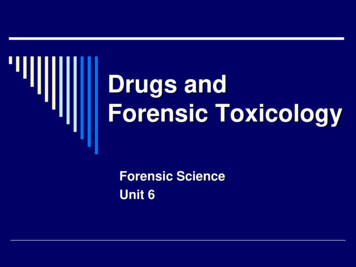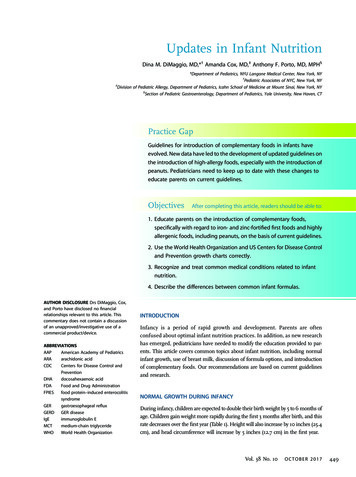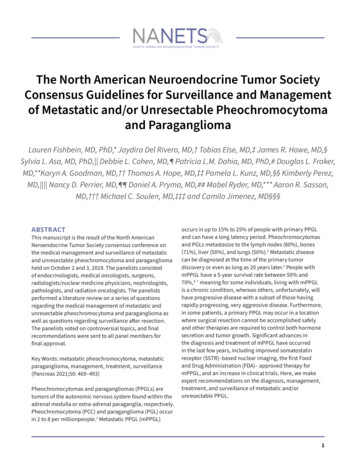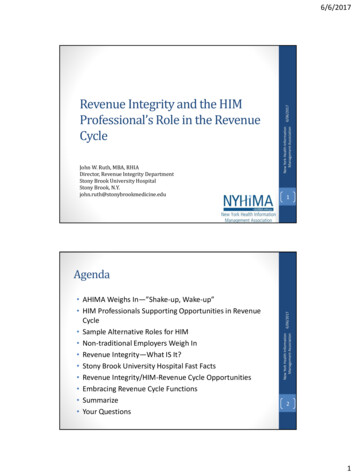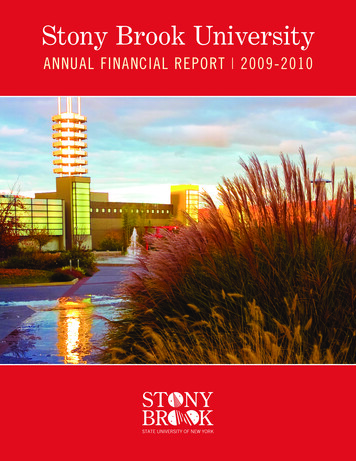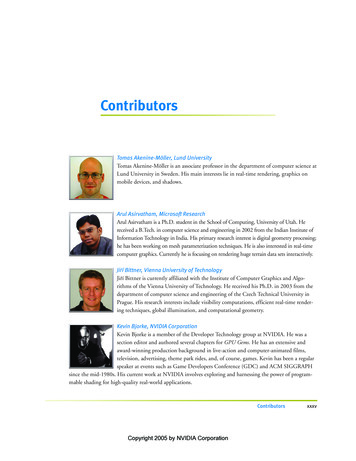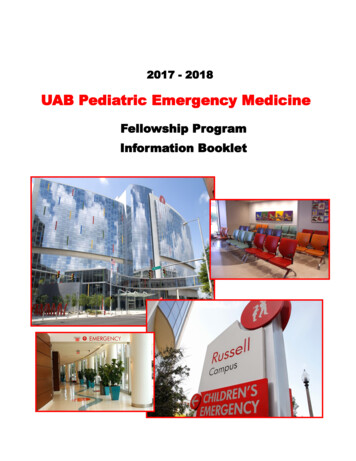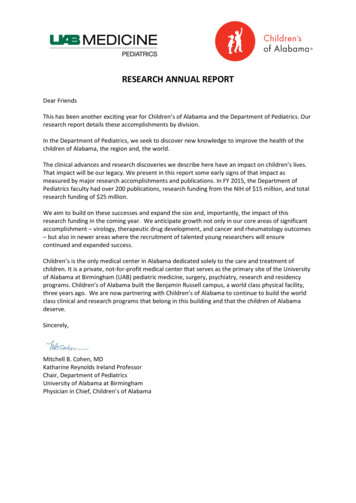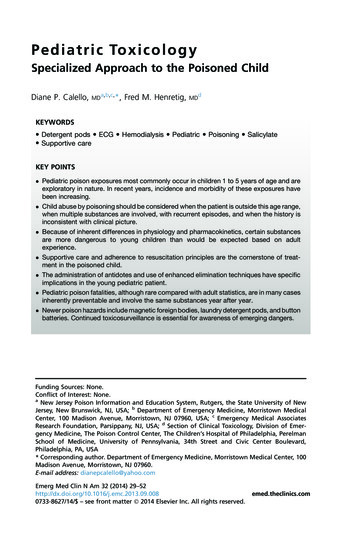
Transcription
P e d i a t r i c Tox i c o l o g ySpecialized Approach to the Poisoned ChildDiane P. Calello,MDa,b,c,*, Fred M. Henretig,MDdKEYWORDS Detergent pods ECG Hemodialysis Pediatric Poisoning Salicylate Supportive careKEY POINTS Pediatric poison exposures most commonly occur in children 1 to 5 years of age and areexploratory in nature. In recent years, incidence and morbidity of these exposures havebeen increasing. Child abuse by poisoning should be considered when the patient is outside this age range,when multiple substances are involved, with recurrent episodes, and when the history isinconsistent with clinical picture. Because of inherent differences in physiology and pharmacokinetics, certain substancesare more dangerous to young children than would be expected based on adultexperience. Supportive care and adherence to resuscitation principles are the cornerstone of treatment in the poisoned child. The administration of antidotes and use of enhanced elimination techniques have specificimplications in the young pediatric patient. Pediatric poison fatalities, although rare compared with adult statistics, are in many casesinherently preventable and involve the same substances year after year. Newer poison hazards include magnetic foreign bodies, laundry detergent pods, and buttonbatteries. Continued toxicosurveillance is essential for awareness of emerging dangers.Funding Sources: None.Conflict of Interest: None.aNew Jersey Poison Information and Education System, Rutgers, the State University of NewJersey, New Brunswick, NJ, USA; b Department of Emergency Medicine, Morristown MedicalCenter, 100 Madison Avenue, Morristown, NJ 07960, USA; c Emergency Medical AssociatesResearch Foundation, Parsippany, NJ, USA; d Section of Clinical Toxicology, Division of Emergency Medicine, The Poison Control Center, The Children’s Hospital of Philadelphia, PerelmanSchool of Medicine, University of Pennsylvania, 34th Street and Civic Center Boulevard,Philadelphia, PA, USA* Corresponding author. Department of Emergency Medicine, Morristown Medical Center, 100Madison Avenue, Morristown, NJ 07960.E-mail address: dianepcalello@yahoo.comEmerg Med Clin N Am 32 (2014) 0733-8627/14/ – see front matter Ó 2014 Elsevier Inc. All rights reserved.emed.theclinics.com
30Calello & HenretigINTRODUCTIONA child is rushed into the emergency department (ED) by anxious parents after the witnessed ingestion of a household product or medication. Such a scenario unfoldsnearly 90,000 times per year in the United States,1 yet it remains a uniquely compellingevent for all the actors involved: patient, family, and medical staff. In the most dramaticof cases, the child’s life depends on the ED staff’s ability to rapidly recognize thepoisoning, institute life support, and provide definitive initial treatment. For mostsuch visits, the family returns home within a few hours, after a period of benign observation, with perhaps a few laboratory tests obtained, or a dose of charcoal administered. Parents might even be advised that next time a quick call to the regionalpoison control center (PCC) would have obviated the ED visit in the first place. However, in every case, it is likely that the patient and family bear some lasting impressionof their ED experience.2 Young children fear strangers (especially physicians) and aremade uncomfortable by even the prospect of the most minor medical interventions.Parents are the natural protectors and sources of comfort for their children whensick, and yet, in the ED setting they often feel obligated to serve in a quasiprofessional helping role. In the context of childhood poisoning, they may also feelconsiderable anxiety about their child’s outcome and guilt for allowing the incidentto have occurred. In essence, they too are patients. Emergency providers (EPs) mayappropriately dread having to draw blood, insert an intravenous (IV) line, or place anasogastric (NG) tube into a screaming toddler, and would gladly omit such interventions if they were medically unnecessary. In the rare context of the critically ill poisonedchild, EPs also welcome the knowledge and confidence to initiate potentially lifesavingtreatment appropriately. This article therefore attempts to guide EPs confronted withthe wide spectrum of pediatric exposures to potentially toxic substances, with a focuson exploratory ingestions in young children and selected toxins that have proved to beparticularly dangerous in this age group. In addition, some attention is given to specialpediatric topics, including particularly poisons that are deadly in small dose; childabuse by poisoning; pediatric medication errors; approach to the well-appearing childwho may have ingested a toxic substance; and new (or resurgent) toxic householdproducts and medication formulations.CAUSE, EPIDEMIOLOGY, AND PREVENTIONChildren may be poisoned by numerous mechanisms, including ingestion, inhalation,dermal contact, envenomation, and transplacental exposure. The focus of this is articleis on the most common of these mechanisms: ingestion. The ingestion of a nonfood,potentially poisonous substance by a young child typically represents a complexinterplay of child-related, substance-related, and environmental factors.3 The termaccidental ingestion was formerly used to describe these common events4–6 but hasfallen out of favor and is now replaced by inadvertent, unintentional, or perhaps mostproperly, exploratory ingestion.7 This usage emphasizes the modern injury modelthat views injuries as predictable events based on several critical factors, not unlikethe infectious disease model, with a victim (or host), agent (or microbe), and a conducive environment, as elucidated by Haddon in 1980.8 Typical poisoning victims arebetween 1 and 5 years of age, at a developmental stage that allows mobility andexpression of normal exploratory behavior, yet too young to learn what is dangerous.9They tend to be more hyperactive and impulsive, and more pica prone.5,10,11 Someagents are more likely to be ingested, either because of ease of access or attractiveness to the youngster.12 A classic example was adult-intended iron tablets that simulated candy, were small, smooth-coated and easy for toddlers to swallow intact, were
Pediatric Toxicologyavailable over the counter, and were typically prescribed to pregnant or postpartumwomen, who often have an older toddler-aged child in the home. As a result, acuteiron poisoning had been one of the leading causes of childhood poisoning mortality until 1997, when the US Food and Drug Administration (FDA) required most iron preparations to be blister packaged (the regulation was subsequently suspended, but manymanufacturers have voluntarily continued this practice, and pediatric iron-relatedmorbidity has since remained low).13 A recent example of a new product that hasproved enticing, and dangerous, to children is laundry detergent pods.14,15 Certainenvironmental changes or stresses are also highly poisoning-prone, including thearrival of a new baby, moving to a new home or apartment, parental illness or disability,and grandparent caretaking or visiting.16–19 The concordance of two or three such factors likely further increases the probability of exploratory ingestion.Given the propensity to exploratory ingesting, many physicians (and parents) swearthat “kids will eat anything.” The number of childhood ingestions are compelling, andthe scope of drugs and nonpharmaceutical agents involved in childhood poisoning isbroad. The American Association of Poison Control Centers (AAPCC) National PoisonData System (NPDS) data reveal an average of more than 1.2 million exposures peryear in children younger than 6 years between 2009 and 2011, the 3 most recent yearsfor which tabulated data were available.20–22 These data typically represent more than50% of all poison-related calls to the nation’s PCCs. Table 1 summarizes the mostcommonly ingested agents reported in 2011. Among these agents are cosmeticsand personal care products, noncorrosive cleaners, and plants, all with a low likelihood of causing serious effects. An excellent effort to stratify the litany of pediatricexposures into those with real toxicologic hazard potential, based on frequency ofoccurrence and inherent toxicity of particular agents (hazard factor), was publishedin 1992.23 For pharmaceuticals, the most hazardous agents at that time were iron supplements, antidepressants, cardiovascular agents, and salicylates (of these, iron inparticular has diminished as a threat through decreased accessibility, as notedearlier). Additional hazardous drugs included opioids, anticonvulsants, chloroquine,Table 1Major substances most often involved in exposures to young childrenaSubstance CategoryPercent of Total SubstancesaCosmetics and personal care products14Analgesics10Cleaning products9Foreign bodies, toys, and so forth7Topical ld and cough medications3Antimicrobials3Gastrointestinal medications3Plants3Rounded to nearest integer.Data from Bronstein AC, Spyker DA, Cantilena LR Jr, et al. 2011 annual report of the AmericanAssociation of Poison Control Centers’ National Poison Data System (NPDS): 29th annual report.Clin Toxicol 2012;50:911–1164.31
32Calello & Henretigisoniazid, theophylline, oral hypoglycemics, and diphenoxylate/atropine. The mosthazardous nonpharmaceutical household products were hydrocarbons, pesticides,alcohols/glycols, drain and oven cleaners, and gun bluing agents that contain selenious acid; several of these remain highly hazardous today. Button batteries would nowalso rank near the top of the list of nonpharmaceutical hazards.24 These and severalnew threats are discussed in more detail later.Of those 3.6 million childhood exposures reported in the United States from 2009 to2011, more than 2500 developed a life-threatening illness, and 109 died of exposurerelated effects.20–22 Yet, these summary data represent a vast improvement inmorbidity and mortality from a half-century ago, when 300 to 500 childhood poisoningdeaths per year were routine. Pediatricians, public health authorities, and consumeradvocates rightfully take great pride in this evolution, believed largely caused by thewidespread use of child-resistant packaging for many medications and hazardoushousehold products after passage of the Poison Prevention Packaging Act in 1970.25Conceptualizing the accidental poisoning of the 1950s in the modern injury modelhas allowed for substantial inroads in poison prevention efforts, primarily by attackingthe toxic agent via decreased accessibility through regulation with child-resistant packaging and household product reformulation to less toxic forms. Additional decreases inchildhood morbidity are undoubtedly caused by the poison center movement andadvances in emergency and hospital-based care for the poisoned patient.Despite these enormous gains, recent data suggest a disturbing trend since 2000that pediatric ingestions, and in particular, related ED visits and hospital admissionsare increasing again.26–28 Analysis of AAPCC data from 2001 to 2008 determinedthat pharmaceutical exposures and related ED visits increased significantly, with parallel increases in injuries and hospital admissions.26 The agents most often involved inserious exposures were prescription medications, particularly oral hypoglycemics,opioid analgesics, sedative/hypnotics, and cardiovascular drugs. It was postulatedthat the best explanation for this disturbing trend was the general increase in suchpotent medications in current use, and thus in the environment of young children.This hypothesis was tested by researchers who compared AAPCC data for pediatricexposures with data from the National Ambulatory Medical Care Surveys for adultintended prescriptions written for 2000 to 2009.28 A striking association of thesevariables was found, particularly for children 0 to 5 years old, and again, for opioidanalgesics, oral hypoglycemics and cardiovascular medications. Thus, challengesremain to further decrease pediatric toxic exposures, and new efforts are beingaddressed, including so-called next-generation safety packaging, which limits flowrate of liquid medications, or use of a blister packet within a traditional childresistant container for pill-form medications.29Two etiologic considerations deserve special comment: malicious poisoning inyoung children and pediatric medication errors. Child abuse by poisoning is uncommon, occurring in only 0.007% to 0.02% of pediatric poisonings reported to theAAPCC.30,31 However, the frequency may be higher when hospital-based cases areanalyzed. One investigation determined that 13% of ED and in-patient pediatric poisonings resulted in consultation to their hospital’s child abuse team, and 4% werereferred to the regional child protective services agency (although many of thesewere for concern of poor supervision, neglect or exposure to illicit substances, ratherthan truly malicious intent).32 Such cases might be especially suspected in poisonedchildren younger than 1 year, or between 5 and 11 or so years old (eg, preadolescent),and when the history is inconsistent or otherwise arouses clinician discomfort. Additional risk factors include previous history of poisoning or siblings who were poisoned;massive overdose; ingestion of multiple agents (unless perhaps the child was found
Pediatric Toxicologywith an open pill minder or equivalent); exposure to illicit drugs; unusual poisoningsfrom common household substances such as salt, pepper, and even water; and evidence of other forms of child abuse or neglect.33–35 The morbidity of such cases tendsto be higher,30,31 and if child abuse is suspected, these patients require prompt reporting to child protective services, meticulous documentation of clinical and laboratoryfindings, and careful attention to chain-of-custody procedures for handling of toxicology specimens.Drug toxicity in young children may also be the result of iatrogenic or parental medication error.35 Children may be more prone to these errors because of several factors,including the inevitable necessity of calculating weight-based or age-based dosing,and the fact that they cannot speak for themselves regarding allergy history or earlysymptoms of an adverse event. Moreover, medically complex children in hospital settings may be at increased risk.36,37 A not uncommon scenario is a 10-fold overdosecaused by calculation error of a mg/kg dose. Alternatively, compounding of medications lacking a standardized pediatric formulation presents the opportunity for errorsin the compounded concentration or on administration of alternative concentrations.Furthermore, potentially toxic medications with multiple pediatric oral suspensionconcentrations exist, such as verapamil, atenolol, carvedilol, labetalol, propranolol,and tacrolimus.38 The frequency and morbidity from pediatric medication errors areconsiderable.39 They account for as many as 6% of all exposures in young children,and for 12% of poisoning deaths in this age group.35 Prevention strategies includecomputerized order entry systems, unit-based clinical pharmacists, and enhanced efforts at communication among health care team providers.40,41PEDIATRIC PATHOPHYSIOLOGIC CONSIDERATIONSPediatric patients respond differently to poisoning than adults, the reasons for whichextend beyond their comparatively smaller size. Myriad differences in the child’s anatomy and physiology affect vulnerability to toxic exposures. In addition, developmentalchanges in drug disposition and effect render some agents unusually toxic in the veryyoung child.Dermal absorption is clearly increased in children, who have a higher body surfacearea/weight ratio, increased skin perfusion, and increased skin hydration.42 There isgreater potential for toxicity from dermal exposures and greater susceptibility to dehydration and insensible losses. Absorption by inhalation is also a particular pediatricvulnerability; the increased respiratory rate and minute ventilation of young childrendeliver a higher dose in a shorter time for many airborne toxins. The most commonof these toxins is carbon monoxide, in which a group of exposed persons have varyingdegrees of symptom severity, the most severe of which are often found in the smallestchild.Because of a higher metabolic rate and decreased reserve, children are more sensitive to hypoxia and respiratory failure. Increased reliance on the diaphragm andlimited capacity of other accessory muscles lead to the abdominal breathing so oftenseen in young children with respiratory distress, and an increased tendency to fatigueand respiratory failure. This situation can affect a child’s resilience to a direct respiratory toxin (such as an aspirated hydrocarbon), as well as the ability to compensate foracid-base disturbances. As a result, children may be more acidemic at initial presentation with salicylism and may have more severe acidemia with other clinical scenarios,such as toxic alcohol poisoning. An additional metabolic vulnerability is a relative lackof glycogen stores, which significantly increases the likelihood of fasting hypoglycemiafrom ethanol, b-receptor antagonists, and other agents altering glucose homeostasis.33
34Calello & HenretigChildren have more limited cardiovascular reserve in response to stress. Cardiacoutput is heavily reliant on heart rate, with limited capacity to augment stroke volume.However, increased adrenergic tone allows for maintenance of normal blood pressureuntil the advanced stages of shock. Thus, a child in impending circulatory failure mayappear deceptively stable, with a normal blood pressure, and tachycardia as a lonevital sign abnormality. When a drug is ingested that alters this fragile balance, a precipitous decline may ensue. For example, drugs inducing bradycardia such as calciumchannel antagonists or organophosphorus pesticides may precipitate circulatoryarrest in very small doses.Although a detailed discussion of pediatric pharmacokinetics and pharmacodynamics is beyond the scope of this review, it is becoming increasingly clear that themanner in which a given drug is absorbed, distributed, metabolized, and excretedchanges considerably throughout childhood.43 Various neurotransmitter receptorsand ion channels also undergo maturation in this period. These developmental alterations in drug distribution and response may explain the long-observed phenomenonof agents that cause specific toxicity only in young children. Several opioid receptoragonists or their structural isomers cause enhanced central nervous system (CNS)and respiratory depression in children, including dextromethorphan cough syrups,clonidine, diphenoxylate antidiarrheals, codeine, and buprenorphine.44–47 Young infants are more prone to paradoxical reactions to benzodiazepines48 and increasedtendency to QTc prolongation with sotalol and other prodysrhythmic drugs.49EMERGENCY MANAGEMENT OVERVIEWDespite the relative infrequency of serious clinical toxicity resulting from most common pediatric exploratory ingestions, as noted earlier, some become seriously ill.Thus, it remains incumbent for EPs to recognize and treat poisoned children.Readily available recent literature offers excellent summaries of the generalapproach to the poisoned patient.50–53 Little modification is necessary in expandingthese overviews to focus on the pediatric situation.54–56 Several comments are offeredthat represent our experience and method of conceptualizing this approach, particularly as it applies to the child who is critically ill or at risk for precipitous decline. Thissuggested approach offers an updated improvement of the senior author’s previouseffort in this regard 20 years ago.3Severe poisoning in a young child may be considered analogous to the modern multiple trauma model and approached in a similar manner.57 A previously well child ispotentially injured in multiple organ systems, with a great variance in the degree of(chemical) injury at each site. There is often a brief window of opportunity for emergencymedical services personnel and EPs to make dramatic interventions that prove lifesaving. Prompt and thorough evaluation of life-threatening conditions accompaniedby sequential immediate intervention (or primary survey) allows for a more detailedsecondary evaluation and detoxification phase (secondary survey). This approach issummarized in Table 2. EPs are well versed in this paradigm, and only a few commentsare here annotated.Life SupportThe initial phase of management includes attention to the traditional ABCs (airway,breathing, circulation) well known to the EP, with some toxicologic expansion toABCD3EF. Additional Ds in this mnemonic stand for disability assessment (eg, briefneurologic examination, such as a level of consciousness, pupillary size, and reactivity), empirical drug therapy (especially oxygen, dextrose, and naloxone), and initial
Pediatric ToxicologyTable 2Emergency management of the poisoned childPhaseActions and ConsiderationsInitial Life Support Phase (ABCD3EF)AirwayEmphasis on protection in obtunded childPossible compromise in caustic exposuresBreathingAdequate oxygenation and ventilationCirculationClose monitoring of vital signs, capillary perfusionEarly IV accessDisabilityLevel of consciousnessPupillary size, reactivityDrugsDextrose ( rapid bedside testing)OxygenNaloxoneOther ACLS medications as neededDecontaminationOcular: copious saline lavageSkin: remove contaminated clothes, copious water, then soap andwaterGI: consider options (often none)ElectrocardiogramRate and rhythmQRS width, QTc lengthTerminal R wave in lead AVRFeverCore temperature check for hyperthermiaEmergent cooling as neededEvaluation, Decontamination, and Supportive Care PhaseHistoryBrief, focusedKnown toxinEstimate amount, elapsed time, early symptoms, hometreatment, PMH?Suspected but unknown toxin, consider ifAcute onset of illness; age 1–5 yPMH of pica, ingestionsCurrent household stressorsMultiorgan system dysfunctionPuzzling clinical pictureNew medication accessSuspicious HPI, PMH, or FH for child abuseInstitute hospital protocolsConsider expanded laboratory testing with chain-of-custodyproceduresPhysical ExaminationVital signs, pulse oximetry (with core temperature)Level of consciousness, neuromuscular statusEyes: pupillary size and reactivity, extraocular movements,nystagmusMouth: corrosive lesions, odors on breath, hydration of mucousmembranesCardiovascular: rate, rhythm, capillary perfusionRespiratory: rate, chest excursion, air entry, auscultatory signsGI: tenderness, bowel soundsSkin: color, bullae, burns, autonomic signs (eg, diaphoretic,flushed, dry)Odors: breath, clothing, vomitus(continued on next page)35
36Calello & HenretigTable 2(continued)PhaseActions and ConsiderationsLaboratory (individualize)CBC, co-oximetryABG or VBG, serum osmolarityChest radiograph, abdominal radiographElectrolytes, BUN, creatinine, glucose, calcium, magnesium,liver function testsRapid overdose toxicology screenQuantitative toxicology tests (especially acetaminophen,salicylate, ethanol)Comprehensive toxicology testing at reference laboratoryAssessment of severityand diagnosisClinical findings (see Table 3 toxidromes)Laboratory and ECG abnormalitiesSpecific detoxification andcontinued supportive careReassess ABCD3EF (always)Consider GI decontamination optionsAntidotal therapy, as indicatedEnhance elimination, as indicatedSupportive care (in every case!)Abbreviations: ABG, arterial blood gas; ACLS, advanced cardiac life support; BUN, blood urea nitrogen; CBC, complete blood count; ECG, electrocardiogram; FH, family history; GI, gastrointestinal;HPI, history of present illness; PMH, past medical history; VBG, venous blood gas.decontamination, with urgent emphasis on ocular and dermal decontaminationand consideration of gastrointestinal decontamination options. E is added to addressa more detailed electrocardiogram evaluation, and an F reminds the practitionerto check core temperature, which may be critically increased (hyperthermia) inmany intoxications.As noted earlier, the poisoned child shows the same precariousness of airway andrespiratory function that complicates infectious (eg, croup, epiglottitis) and otherCNS-depressed (eg, cranial injury) states. Seriously poisoned children often passrapidly from obtundation with minimally impaired respiration to deep coma and apnea,and even those with seemingly normal respiratory drive may suffer airway obstructionbecause of narrow airway caliber, copious secretions, and depressed airway protective reflexes. Patients may vomit or be selected to undergo NG tube administration ofactivated charcoal (AC), which poses aspiration risks. Blood gas analysis may help inassessing ventilatory status, but in our view, EPs should usually rely on clinical judgment and maintain a low threshold for endotracheal intubation for definitive airwayprotection and to ensure adequate ventilation in the significantly obtunded, poisonedchild. This approach allows for an orderly, if urgent, elective intubation, and obviatesthe chaos of a precipitous pediatric arrest.Similarly, any symptomatic poisoned child deserves early assessment of cardiacrate and rhythm (including a 12-lead electrocardiogram [ECG]), blood pressure andcapillary perfusion, and rapid attainment of IV access. The poisoned child in cardiacarrest or with severe hemodynamic compromise requires an approach that generallyfollows established American Heart Association guidelines for pediatric advanced lifesupport.58 Occasional exceptions to this rule include the early use of sodium bicarbonate in advanced cyclic antidepressant (or other sodium channel blocking agent)toxicity or additional specific antidotal therapy for other cardiotoxic drugs, such asdigitalis antibodies for severe digoxin overdose, glucagon for b-adrenergic blocker(BB) toxicity, and calcium and insulin/glucose therapy for severe calcium channel
Pediatric Toxicologyblocker (CCB) toxicity.59,60 For the child who has not arrested, but is in shock, theinitial management usually begins with IV crystalloid fluids (eg, 20 mL/kg bolus,repeated and titrated to clinical effect), again followed by specific antidotes if suchare appropriate. Cautious use of inotropes is warranted for persistent shock after circulatory filling has been achieved. Such severe cases should prompt seeking emergent toxicology advice from an in-house consultant or a call to the PCC.The use of empirical drug therapy in obtunded young children who are poisoned, orpotentially so, is similar to that in adults, with the exception of the routine use of thiamine. Although pediatricians and emergency physicians are usually timely in theirconsideration and use of dextrose, they may occasionally omit a trial of naloxone intoddlers. However, many opioids are available to toddlers in the form of prescriptionanalgesics (which increased in the past decade, as noted earlier), antidiarrheal preparations, cough medicines, or illicit drugs, as well as the partially naloxone-responsiveantihypertensive agent clonidine.61 All potentially poisoned obtunded children deservea trial of naloxone. Toddlers who are deeply obtunded or apneic may be treated immediately with relatively high doses, by adult standards, with little fear of precipitatingwithdrawal; we routinely initiate therapy with 0.1 mg/kg (or 1–2 mg) IV.62 This therapymay be repeated when necessary if opioid toxicity is highly suspected, especially foragents such as methadone, fentanyl, buprenorphine, and clonidine.As mentioned earlier, dextrose administration is a potentially critical intervention,and should be considered early in the approach to the comatose or seizing child. Arapid bedside test for blood glucose may be useful if it is clearly in the normal range,but one should be wary of relying on a borderline reading. In addition to coma or seizures, patients with hypoglycemia may show an atypical neuropsychiatric picture, withaphasia, slurred speech, and focal neurologic signs. Hypoglycemia is frequently seenafter ethanol ingestions in toddlers (as opposed to adults),63 as well as in ingestions oforal hypoglycemics, and occasionally with b-blocker and salicylate intoxication. Theinitial dose is 0.5 g/kg dextrose, which is provided as a 25% solution (2 mL/kg) in toddlers or as a 10% solution (5 mL/kg) in infants in order to minimize osmotic shifts fromthe typical 50% adult solution.Additional advanced life support medications and anticonvulsants are used asneeded. Dysrhythmias caused by poisonings are often the result of sodium channelor potassium channel blockade and may be worsened by traditional antiarrhythmicdrugs. The former are often effectively treated with sodium bicarbonate and the latterby magnesium infusion or override pacing. Toxin-induced seizures tend to respondbest to benzodiazepine therapy, titrated to effect. A barbiturate is often a preferredsecond-line agent. Phenytoin is relatively ineffective for almost all toxin-induced seizures. Blood glucose should be checked in all seizing patients. Pyridoxine is a specificantidote for isoniazid-induced seizures. The occurrence of toxin-induced dysrhythmias or seizures, especially if refractory to initial therapy, should again suggest thepotential value of an emergent toxicology consult or call to the regional PCC.Rarely, a young poisoned child might manifest extreme hyperthermia. This complication may occur after overdose of several classes of drugs, including sympathomimetics,anticholinergics, salicylates, and other uncouplers of oxidative phosphorylation, as wellas in the context of the specific drug-induced hyperthermic syndromes, including malignant hyperthermia, serotonin syndrome, and neuroleptic malignant syndrome.64 Oneadditional hyperthermic scenario, that of alcohol or sedative/hypnotic withdrawal, ishighly unlikely i
Pediatric Toxicology Specialized Approach to the Poisoned Child Diane P. Calello, MDa,b,c,*, Fred M. Henretig, MDd Funding Sources: None. Conflict of Interest: None. a New Jersey Poison Information and Education System, Rutgers, the State University of New Jersey, New Brunswick, NJ, USA; b Department of Eme
